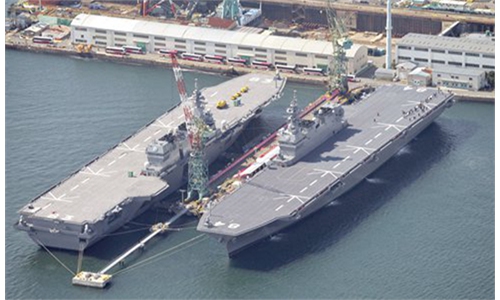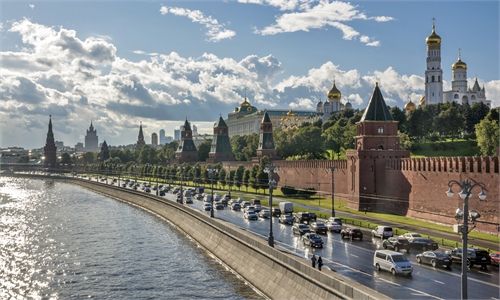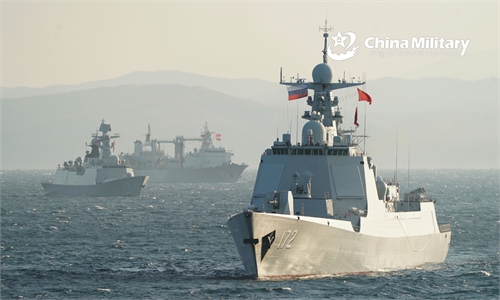Chinese, Russian vessels join drills to uphold post-WWII global order
Referring to history, regional countries still remain alert to Japan’s militarism
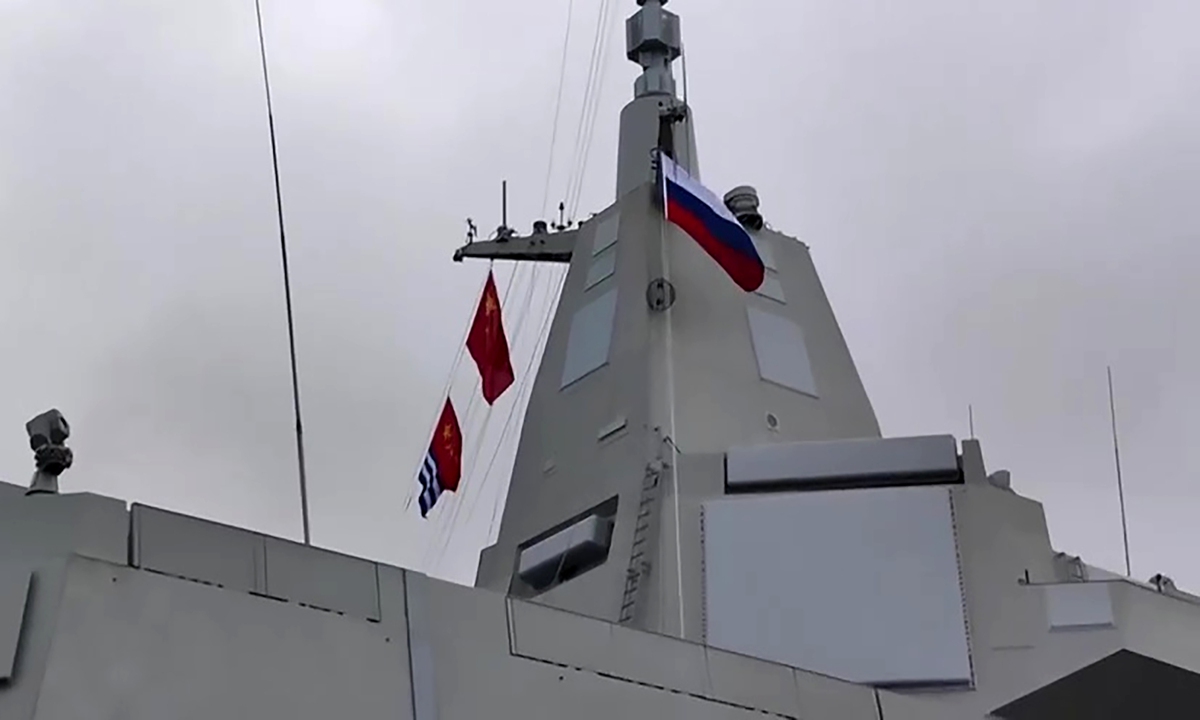
The Type 055 large destroyer Nanchang attached to the navy of the Chinese People's Liberation Army (PLA) Northern Theater Command is seen during deployment as part of the Russian Vostok 2022 strategic military drills lasting through September 7, 2022. The Russian Defense Ministry published footage of the meeting of the two countries' warships in the Sea of Japan on September 2, 2022. Photo: VCG
Flotillas of Chinese and Russian naval vessels participating in the ongoing Vostok 2022 (East 2022) joint drills met in the northern part of the Sea of Japan on Friday, which was the 77th anniversary of Japanese representatives signing the official Instrument of Surrender after Japan's unjust war brought tremendous injuries and pain to people across Asia.
Observers noted that China and Russia, as two major regional powers, are committed to jointly maintaining regional peace, stability and the post-WWII global order.
This is of great significance at a time of complex changes in the regional situation, including Japan's obvious militarist tendency, which has a historical relevance.
In footage released by China Central Television, China's 10,000 ton-class Type 055 large destroyer Nanchang sailed along with other naval vessels. Earlier news reports said the Chinese flotilla also included the Type 054A guided missile frigate Yancheng and the Type 903A comprehensive supply ship Dongpinghu.
While the drills are neither aimed at a third party nor related to the current situation, they serve as a deterrent against uncertainties such as ill-intended external forces, hegemony and power politics, analysts said, noting that military cooperation between China and Russia, two major world powers, will contribute to peace and stability in the region.
Yet Japan protested the drills, when its own Ground Self-Defense Force joined drills with the US Army to simulate the defense of remote islands, Japanese broadcaster NHK reported on August 28. The drills are believed to be intended to deter China, the NHK reported.
Japanese Foreign Minister Yoshimasa Hayashi expressed at a news briefing on Friday his willingness to talk with China, and noted dialogues with China at various levels are important. However, he also hyped the "threats" of People's Liberation Army's (PLA) operations surrounding the island of Taiwan and on the East China Sea.
Remembering history
Japan has been using China as the main excuse to "justify" its own increasing military activity and attempts to boost its military capacity. But scars left by a militarized Japan remain vivid and painful in victimized countries more than seven decades after the WWII ended.
Prior to the anniversary of the victory in the Chinese People's War of Resistance Against Japanese Aggression (1931-45) on September 3, Chinese people held various events including attending exhibitions of old pictures and watching documentaries, to commemorate the courage, solidarity and great sacrifices made by their ancestors in the arduous war.
On social media, Chinese netizens posted old photos of Japanese representatives signing the surrender document, of battles, and of people celebrating the victory in the streets.
"Remember history and our generation should strive for self-improvement!" read a common post.
A special sale featuring war-themed works was held at a bookstore in Wangfujing, a bustling shopping area in downtown Beijing.
An item of current news also aroused strong national feelings. Evan Kail, a US pawnbroker, posted on social media an album he claimed to date to World War II and contained more than 30 pictures of the Nanjing Massacre — Japanese troops' brutal crimes against civilians, and blatant war atrocities, which Japan has continuously been attempting to deny and cover up.
There has been plentiful evidence of Japanese troops' inhumanity, while more and more of this is being uncovered. "How can they be blind to this?" a net user posted on Sina Weibo.
No wonder regional countries, including China, are highly alert to Japan's latest militarist tendency, Lü Chao, a research fellow at the Liaoning Academy of Social Sciences, told the Global Times on Friday.
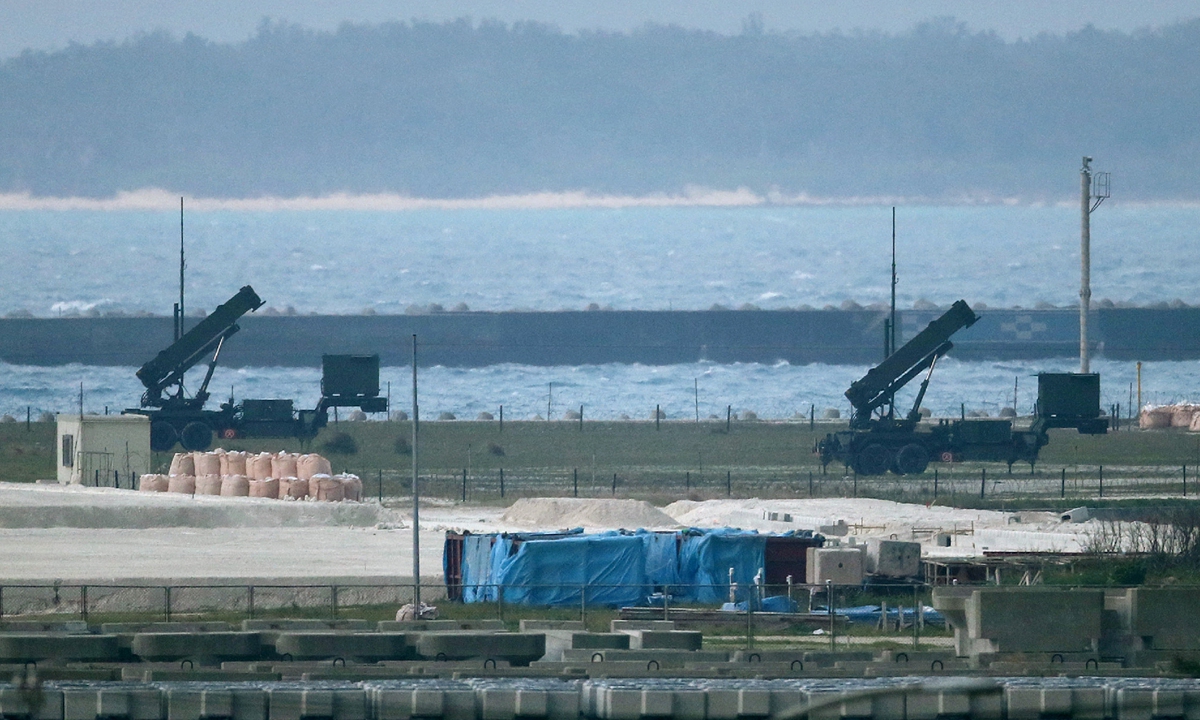
Japanese Self-Defense Force ground-based Patriot Advanced Capability-3 (PAC-3) interceptors are seen in position on the grounds in Ishigaki, Okinawa prefecture on February 7, 2016.Photo: AFP
Japan's defense authority boasted on Wednesday of producing longer-range and hypersonic missiles, and of greatly boosting Japan's defense budget for the next year, which shows a clear yet dangerous tendency of Japan's militarism rebounding and right-wing forces growing stronger, Lü said.
Japan caps annual defense spending at about 1 percent of its GDP, but the ruling Liberal Democratic Party (LDP) proposes doubling it in the coming years, citing NATO's standard of 2 percent, according to Reuters.
Song Zhongping, a Chinese mainland military expert and TV commentator, told the Global Times on Friday that such a spending goal not only indicates Japan's attempt to meet the threshold for NATO membership, but also exposes Japan's desire to break away from its pacifist constitution.
Japan has never really reflected on history and its war-time crimes, with many in the country believing its defeat in the WWII was the result of being "not strong enough." In the past few decades, Japan was restrained by the pacifist constitution and the post-war global and regional order, and it has always dreamed of "shaking off those fetters," observers said.
Though opposing voices remain among ordinary Japanese people, the consensus on amending the pacifist constitution is forming rapidly, experts said.
A poll conducted by Japanese news outlet the Asahi Shimbun in May showed 56 percent of those surveyed agreed on the necessity to revise the constitution, while 37 percent opposed it or deemed the revision unnecessary.
In 2020, however, only 43 percent supported the move while 46 percent did not, and in 2019, it was 30 percent supporting vs 56 percent opposing.
Xiang Haoyu, a research fellow at the China Institute of International Studies, wrote earlier in an article for the Global Times that the LDP never abandoned this agenda, but just postponed it for a certain period of time to prioritize economic development. Through new interpretations of the pacifist constitution in recent years, the LDP has indeed hollowed out the document.
For Japan's right wing, the pacifist constitution is a symbol of Japan's defeat in WWII. Japan actually refused to acknowledge its wrongdoings during the WWII and the results of the Tokyo Trial, believing the constitution should be revised, Xiang noted.
There is a strong "sense of victimhood" in Japanese society, despite the reality that it was imperialist Japan that had brought disasters to Asia.
Refusing to learn lessons from history and to reflect on its own mistakes, today's Japan remains a factor of uncertainty and a disturber of regional peace and stability, Lü said, citing Japan's active participation in military pacts like the Quad and frequent joint drills with its allies.
At a key historical juncture, when the world, especially the Asia-Pacific, is witnessing major and complex changes, when dangerous militarism is rebounding in Japan and when external forces are continuously stirring up trouble in the region, it is the responsibility of major regional countries like China and Russia to join hands in maintaining peace and stability, experts said.
